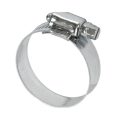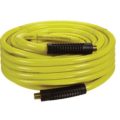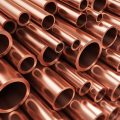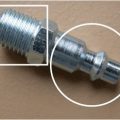Hey! This site is reader-supported and we earn commissions if you purchase products from retailers after clicking on a link from our site.
A common question pondered by many compressed air users is whether they can use PEX for airlines within their system given that it’s so affordable.
This page will provide you with all the necessary information on what exactly PEX is, whether it can be used for compressed air and the considerations to take when choosing it.
Table of Contents
- What is PEX?
- PEX Pipe for Compressed Air
- PEX-AL-PEX Pipe for Compressed Air
- Advantages vs. Disadvantages of Using PEX-AL-PEX Pipe
- PEX-AL-PEX Usage for Compressed Air Tips
- FAQs (Frequently Asked Questions)
What is PEX?
PEX is a version of polyethylene (PE) that has undergone a change in its molecular structure. Here, the polymer chains are cross-linked (X) so to speak to form a three-dimensional flexible network.
PEX for compressed air piping is a cheap and affordable material that is often turned to as an alternative to your typical, and more expensive, metal piping networks for compressed air systems.
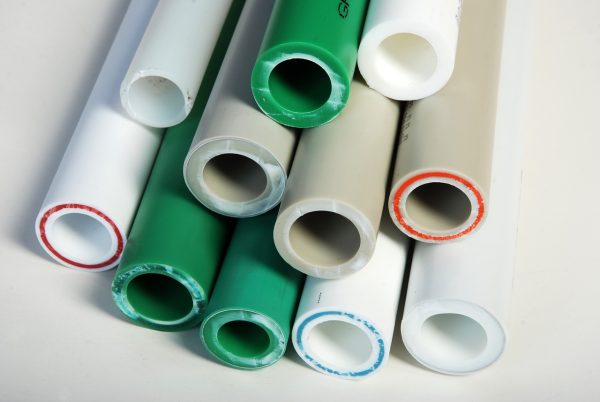
PEX Pipe for Compressed Air
PEX pipe for airlines is more resilient against temperature fluctuations than other commonly used materials and is flexible, meaning you don’t need as many connections between piping and can instead run a long length of pipe without so much worry. This saves significant costs of extra fittings which outweigh the cheap cost of PEX piping itself.
However, PEX piping is not rated for compressed air systems and is very susceptible to UV damage. This makes PEX not suitable for outdoor use as the UV rays can significantly damage it, so it is best suited to indoor airlines and those inside walls.
Though, with that being said, there are examples of PEX tubing for air supply being exposed to direct fluorescent light and indirect sunlight and still performing well. It’s more of a recommendation to not expose it to UV light as direct UV light could cause pipe failure within 30 days.
Being exposed, or left outdoors, the pipe will harden and eventually crack. Using PEX for compressed air is also said, in some cases, to allow tiny amounts of air to leak through the plastic itself which is of course not by any means ideal in compressed air systems.
There are very few (if any) PEX pipes that are stated as actually being sufficient to use with compressed air because most don’t specify. Therefore it is important to check the pressure ratings of the pipe and compare them with your compressor output before purchasing some.
Insulation may be worth considering, as the lack of PEX piping could lead to very unfortunate outcomes. It is not as good as a conductor of heat and cold as metal materials are which can make it an admirable choice.
Note: PEX is NOT rated for compressed air but instead is rated as a water pipe. Yes, many people use PEX for compressed airlines, however, this should come with the realization you’re using something for which its makers do not recommend, approve or condone.
What Pressure Does PEX Pipe Burst?
PEX A vs PEX B
Curious about the different types of PEX pipe? Here’s an informational YouTube video! Also, check out our Pex A vs Pex B Pipe & Fittings guide!
PEX-AL-PEX Pipe for Compressed Air
It is advised that a PEX-AL-PEX combination, simply called PAP pipes, is the best for compressed air to deal with high pressures as it has little or no vapor permeability. PAP is widely used in commercial and residential plumbing networks and more importantly, in pressure services on compressed gas and compressed air systems.
PAP is specifically made for airlines and contains an aluminum layer sandwiched between two layers of PEX, though it is a little bit more expensive, it is a lot stronger. The finished product is flexible, bendable, non-corroding, and resistant to most oils.
PEX-AL-PEX Key Features
PAP boasts the following two key features that can be extremely desirable in compressed air systems:
- Easy Joint Assembly
- Flexibility
Easy Joint Assembly
PAP joints are typically made with compression fittings or crimp-on-connector rings that allow the easy and fast connection of piping without the need to solder and torch them. Unless you’re combining new PAP piping with existing aluminum or copper supply piping.
Flexibility
Possibly their most admirable trait is how flexible they are. You can bend them with your hands in almost any direction and they will stay in this fixed position. This can allow you to work around and through existing frame members, walls, and joists in your garage or workshop.
PAP pipes can tightly bend up to a 3-inch radius without any kinks, which lessens the need for elbow fittings and therefore saves you some significant costs over the course of the whole network!
Advantages vs. Disadvantages of Using PEX-AL-PEX Pipe
Now, let’s compare the advantages versus the disadvantages of using PEX piping.
Advantages of Using PEX-AL-PEX Pipe
- Cheap
- Flexible
- Easy to modify
- Installation doesn’t require soldering
- Corrosion-resistant
- Can be connected to existing metal supply lines with correct fittings
- More resistant to freeze-cracking than metal piping
Disadvantages of Using PEX-AL-PEX Pipe
- Moisture Issues (can be solved with filters)
- Susceptible to UV light
- Not suitable outdoors
- Can’t be recycled
- It May require special connectors and tools for setup
If you’re setting up your compressed air network inside your garage or workshop away from direct UV light, it is clear that the advantages outweigh the disadvantages.
On the contrary, if you’re setting up your compressed air network to have parts outside or near windows that are exposed to direct UV light, this material may not be suited to you.
PEX-AL-PEX Usage for Compressed Air Tips
I’ll leave you with some final tips for using PEX, or should I say more specifically, PAP piping for your air compressor setup. These are:
- Store your PEX indoors and away from sunny windows to avoid pipe degradation due to direct UV light
- Use recommended PEX connections (i.e. PEX crimping tool for crimping a connecting ring)
- Use specific PEX cutters to ensure you make a clean cut on the pipe if necessary to do so
- Insert a filter at suitable points on the line (typically before the end user) to remove moisture and other contaminants
- Ensure the PEX pressure capabilities exceed your compressor working pressure
For alternatives, please visit our Guide: Best Compressed Air Pipeline Materials For Compressed Air Piping Systems!
FAQs (Frequently Asked Questions)
Yeah, the right kind of PEX pipe (PEX-AL-PEX). PEX piping itself is not exactly rated for compressed air systems and is very susceptible to UV damage so it should only be used indoors and away from windows with direct sunlight. Whilst PEX-AL-PEX pipe can deal with the high pressures in compressed air systems as it has little or no vapor permeability.
PEX-AL-PEX is the recommended type for compressed air and is specifically made for this service. It contains an aluminum layer between the two PEX layers allowing the finished product to boast good flexibility, non-corrosion, and resistance traits.
Most PEX tubing will be rated for 160 psi at 73°F, 100 psi at 180°F, and 80 psi at 200°F. Though, it can withstand pressures up to around 800 psi before actually bursting or cracking.
Though more expensive, metal piping is typically the best choice for a compressed air system. Their strong resistance to corrosion and leaks make them an ideal choice, with aluminum and copper being the most common.
Yes, PEX will hold compressed air at pressure. Though PEX Pipe manufacturers don’t rate PEX for compressed air use.
Additional Reading:
- Using Aluminum Air Pipe For Compressed Air
- Copper Pipe For Compressed Air
- Galvanized vs Black Pipe For Air, Gas And Water
- Using ABS Pipe For Compressed Air
- Using Nylon Tubing For Compressed Air
- PVC Air Lines
- Best Compressed Air Pipeline Materials For Compressed Air Piping Systems
- Steel vs Brass Air Fittings
- Industrial vs Automotive Air Fittings
- Compressed Air Metric Fittings
- Air Hose Fittings Types – Guide To Air Compressor Coupler Types
- Compressed Air Fittings Guide
- Air Compressor Hose & Tube Guide
- Using Pex-Al-Pex Compressed Air & Pex-Al-Pex Fittings
- Pex A vs Pex B Pipe & Fittings
- PEX Fitting Types Guide
- How to Plumb an Air Compressor Setup in Garage
If you have any questions regarding PEX piping for air compressor systems, please leave a comment below, with a photo if applicable, so that someone may help you!

